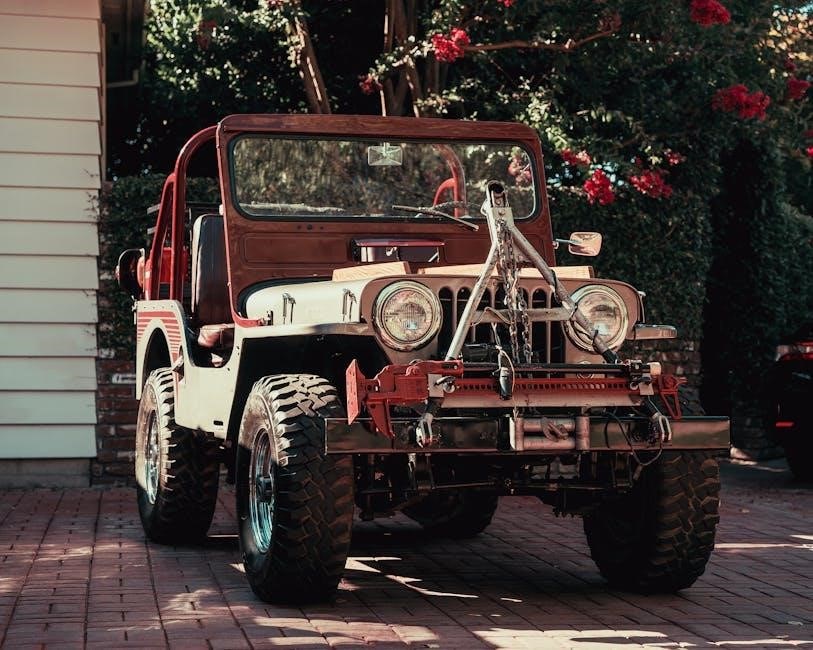Restoring a Jeep CJ5 requires patience and dedication, starting with a thorough assessment and planning phase, using online resources and repair manuals for guidance always carefully.
Background Information
The Jeep CJ5 has a rich history, with production spanning from 1955 to 1983, and its popularity endures among off-road enthusiasts and collectors. Many resources are available for restoration, including online forums and repair manuals. The Jeep CJ5 was widely used for trail driving and street use, making it a versatile vehicle. Restoration projects often involve repairing and replacing original parts, which can be challenging due to the vehicle’s age. However, the demand for parts has generated an aftermarket supply chain, making it easier to find replacement components. With the right guidance and resources, restoring a Jeep CJ5 can be a rewarding experience, allowing owners to preserve the vehicle’s history and enjoy its unique character. Online communities and specialized businesses also provide valuable support and expertise for Jeep CJ5 restoration projects, sharing knowledge and best practices.

Assessment and Planning
Evaluating the vehicle’s condition and creating a restoration plan is crucial for success always using online resources carefully.
Pre-Restoration Evaluation
A pre-restoration evaluation is essential to determine the extent of work required, using a combination of visual inspections and mechanical tests to identify areas of concern. This evaluation process helps to create a detailed restoration plan, ensuring that all necessary repairs and replacements are accounted for. By thoroughly assessing the vehicle’s condition, owners can prioritize tasks, establish a budget, and make informed decisions about the restoration process. Online forums and repair manuals can provide valuable guidance and support during this critical phase, helping to ensure a successful and stress-free restoration experience for Jeep CJ5 enthusiasts, with access to a wide range of resources and expertise. The evaluation process sets the stage for a well-planned and effective restoration, ultimately leading to a beautifully restored vehicle.

Disassembly and Frame Work
Frame inspection and repair are crucial steps, requiring careful attention to detail always, using specialized tools and techniques to ensure a successful outcome every time.
Removing Components and Inspecting the Frame
Removing components and inspecting the frame is a critical step in the restoration process, requiring patience and attention to detail. This involves taking out the engine, transmission, and other components to access the frame. The frame should be thoroughly inspected for any damage, rust, or wear, and repairs should be made as needed. A thorough inspection will help identify any potential issues and ensure a successful restoration. The use of specialized tools and techniques is necessary to ensure a proper inspection and repair. By following a step-by-step approach, restorers can ensure that the frame is properly inspected and repaired, providing a solid foundation for the rest of the restoration process, and ultimately leading to a successful and high-quality restoration of the Jeep CJ5, with a focus on detail and quality.

Body and Mechanical Restoration
Restoring the body and mechanical components requires careful planning and execution always using specialized tools and techniques for optimal results and success.
Repairing and Replacing Body Panels and Mechanical Components
Repairing and replacing body panels and mechanical components is a crucial step in the restoration process, requiring attention to detail and precision.
The use of specialized tools and techniques is necessary to achieve optimal results.
Online forums and repair manuals can provide valuable guidance and support throughout the process.
Additionally, sourcing original or compatible parts can be a challenge, but essential for maintaining the vehicle’s authenticity.
A thorough inspection of the vehicle’s components is necessary to determine the extent of the repairs needed.
By following a systematic approach, enthusiasts can ensure a successful restoration of their Jeep CJ5, preserving its original charm and character.
The end result is a vehicle that is both functional and aesthetically pleasing, making the restoration process a rewarding experience.
Overall, patience and dedication are key to a successful restoration.

Electrical and Interior Restoration
Restoring electrical and interior components requires careful planning and execution always using correct materials and techniques for optimal results and safety.
Upgrading Electrical Systems and Restoring Interior Components
Upgrading electrical systems and restoring interior components is a crucial step in the restoration process, requiring careful planning and execution to ensure optimal results and safety.
Using correct materials and techniques is essential to avoid any potential hazards or malfunctions.
The interior components, such as seats, dashboard, and flooring, must be restored to their original condition or replaced with new ones that match the original specifications.
Electrical systems, including wiring, lights, and accessories, must be upgraded to meet modern safety standards and ensure reliable performance.
Online resources and repair manuals can provide valuable guidance and tips for this complex process, helping restorers to achieve professional-looking results and enjoy a safe and comfortable driving experience.
By following established guidelines and best practices, restorers can create a beautifully restored interior and a reliable electrical system that will last for years to come, providing a unique and rewarding driving experience.
Final Assembly and Detailing
Reassembling the vehicle with attention to detail and finishing touches carefully always.
Reassembling the Vehicle and Adding Final Touches
Reassembling the vehicle is a crucial step in the restoration process, requiring patience and attention to detail. The goal is to ensure that all components are properly installed and functioning as intended. This involves carefully reconnecting electrical systems, reinstalling interior and exterior components, and making any necessary adjustments. Additionally, final touches such as polishing and detailing can make a significant difference in the overall appearance of the vehicle. By following a meticulous approach, enthusiasts can achieve a high-quality restoration that meets their standards. Online forums and repair manuals can provide valuable guidance and support throughout the reassembly process, helping to ensure a successful outcome. With careful planning and execution, the finished vehicle can be a source of pride and enjoyment for years to come, with its original charm and character restored.